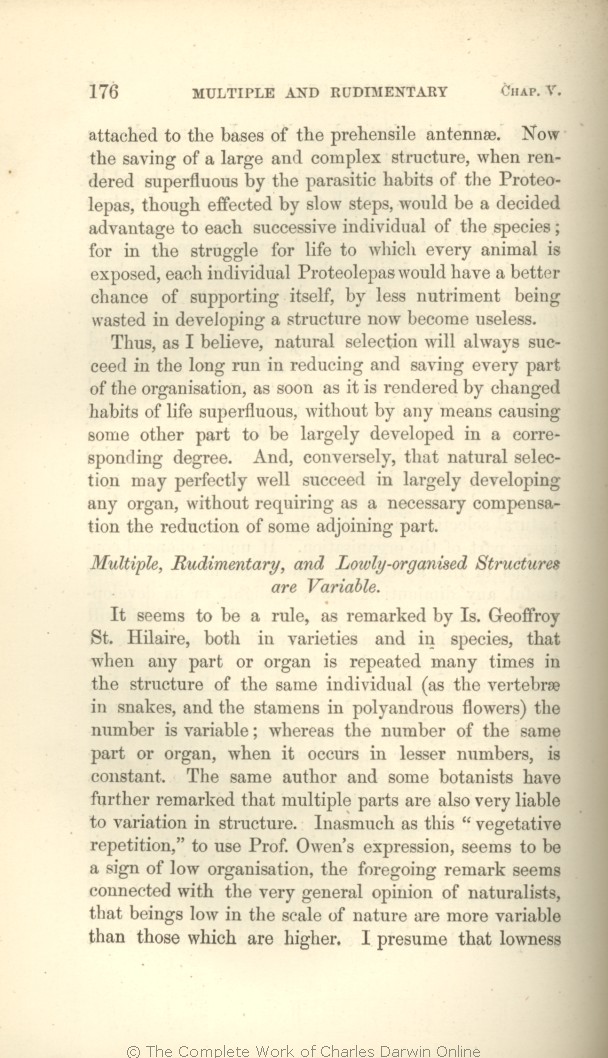attached to the bases of the prehensile antennæ. Now the saving of a large and complex structure, when rendered
superfluous | superfluous 1859 1860 1861 1866 1869 | | superfluous, 1872 |
| by the parasitic habits 1859 1860 1861 1866 1869 |
| would be a decided advantage to each successive individual 1872 |
| Proteolepas, though effected by slow steps, would be a decided advantage to each successive individual of the 1859 1860 1861 1866 1869 |
| OMIT 1872 |
| individual Proteolepas 1859 1860 1861 1866 1869 | individual Proteolepas 1872 |
| wasted 1859 1860 1861 1866 1869 | | wasted. 1872 |
| in 1859 1860 1861 1866 1869 | in 1872 |
| developing 1859 1860 1861 1866 1869 | developing 1872 |
| a 1859 1860 1861 1866 1869 | a 1872 |
| structure 1859 1860 1861 1866 1869 | structure 1872 |
| now 1859 1860 1861 1866 1869 | now 1872 |
| become 1859 1860 1861 1866 1869 | become 1872 |
| useless. 1859 1860 1861 1866 1869 | useless. 1872 |
|
|
Thus, as I believe, natural selection will
always succeed | always succeed 1859 1860 1861 1866 1869 | | tend 1872 |
| in reducing and saving every 1859 1860 1861 1866 1869 |
| to reduce any 1872 |
| is rendered 1859 1860 1861 1866 1869 |
| becomes, through changed habits, 1872 |
| by changed habits of life superfluous, 1866 1869 |
| superfluous, 1859 1860 1861 1872 |
| any 1859 1860 1861 1866 1869 | | an 1872 |
| organ, 1859 1860 1861 1866 1869 | | organ 1872 |
|
Multiple,
Rudimentary,
and
Lowly-organised
Structures
are
Variable
.
|
Variable
.
1866 1869 | |
Variable
. 1872 |
|
It seems to be a rule, as remarked by Is. Geoffroy St. Hilaire, both
in | in 1859 1860 1861 1866 1869 | | with 1872 |
| in 1859 1860 1861 1866 1869 | in 1872 |
| structure of the 1859 1860 1861 1866 1869 |
| OMIT 1872 |
| number of the 1859 1860 1861 1866 1869 |
| OMIT 1872 |
| and 1859 1860 1861 1866 1869 |
| as well as 1872 |
| also very 1859 1860 1861 1866 1869 | | extremely 1872 |
| variation 1859 1860 1861 1866 1869 | | vary 1872 |
| Inasmuch as this 1859 1860 1861 1866 1869 |
| As 1872 |
| Owen's 1859 1861 1866 1872 | | Owens 1860 1869 |
| seems to be 1859 1860 1861 1866 1869 |
| is 1872 |
| organisation, 1860 1861 1866 1869 1872 | | organisation; 1859 |
| remark seems connected 1859 1860 1861 1866 1869 |
| statements accord 1872 |
| very general 1859 1860 1861 1866 1869 | | common 1872 |
| low 1859 1860 1861 1866 1869 |
| which stand low 1872 |
|









